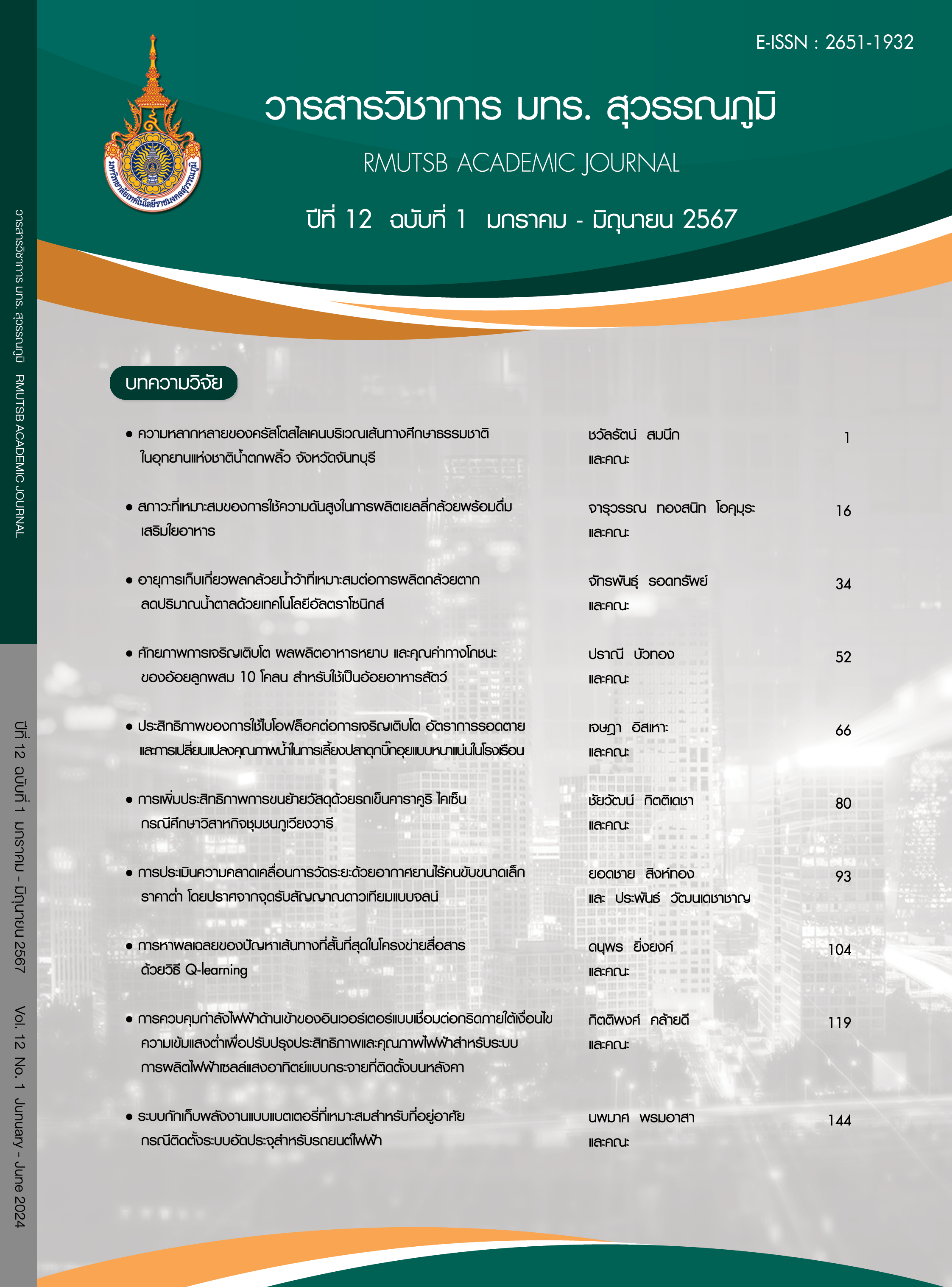การควบคุมกำลังไฟฟ้าด้านเข้าของอินเวอร์เตอร์แบบเชื่อมต่อกริดภายใต้เงื่อนไขความเข้มแสงต่ำเพื่อปรับปรุงประสิทธิภาพและคุณภาพไฟฟ้าสำหรับระบบการผลิตไฟฟ้าเซลล์แสงอาทิตย์แบบกระจายที่ติดตั้งบนหลังคา
Main Article Content
บทคัดย่อ
จากแนวโน้มระบบการผลิตไฟฟ้าเซลล์แสงอาทิตย์แบบติดตั้งบนหลังคาที่เพิ่มขึ้นและสมรรถนะที่ลดลงของอินเวอร์เตอร์แบบเชื่อมต่อกริดในช่วงโหลดน้อยจากความเข้มแสงต่ำ บทความนี้นำเสนอการปรับปรุงประสิทธิภาพและคุณภาพไฟฟ้าของระบบการผลิตไฟฟ้าจากเซลล์แสงอาทิตย์แบบเชื่อมต่อกริดที่ใช้อินเวอร์เตอร์แบบกระจายโดยอาศัยการควบคุมกำลังไฟฟ้าของเซลล์แสงอาทิตย์ที่ป้อนให้กับอินเวอร์เตอร์ในช่วงความเข้มแสงต่ำ ในบทความได้ใช้ความสัมพันธ์ระหว่างประสิทธิภาพกับกำลังไฟฟ้าของอินเวอร์เตอร์จากผลการจำลองด้วยโปรแกรม PVsyst เพื่อเป็นข้อมูลในการควบคุมกำลังไฟฟ้าที่ป้อนให้กับอินเวอร์เตอร์อย่างเหมาะสมตามกำลังไฟฟ้าของแผงเซลล์แสงอาทิตย์ที่เปลี่ยนแปลงตามความเข้มแสง นอกจากนั้นในบทความนี้ยังได้พิจารณากำลังไฟฟ้าที่แตกต่างกันต่อกระแสฮาร์มอนิกด้วย ผลการวิจัยแสดงให้เห็นว่า วิธีการที่นำเสนอสามารถเพิ่มกำลังไฟฟ้าด้านออกในช่วงความเข้มแสงต่ำให้สูงขึ้นจาก 63.29 วัตต์ เป็น 76.58 วัตต์ ทำให้ประสิทธิภาพของวิธีการที่นำเสนอเพิ่มสูงขึ้นมากกว่าระบบการผลิตไฟฟ้าเซลล์แสงอาทิตย์แบบดั้งเดิม ลักษณะดังกล่าวจึงทำให้สามารถผลิตพลังงานไฟฟ้าได้เพิ่มขึ้น 21 เปอร์เซ็นต์ นอกจากนั้นผลการทดสอบยังยืนยันให้เห็นด้วยว่าการเพิ่มกำลังไฟฟ้าในช่วงความเข้มแสงต่ำจะมีผลทำให้ค่าความผิดเพี้ยนรวมของกระแสลดลงจากเดิม 18 เปอร์เซ็นต์ เหลือเพียง 11.25 เปอร์เซ็นต์ อีกด้วย
Article Details

อนุญาตภายใต้เงื่อนไข Creative Commons Attribution-NonCommercial-NoDerivatives 4.0 International License.
ต้นฉบับที่ได้รับการตีพิมพ์ถือเป็นสิทธิของเจ้าของต้นฉบับและของวารสารวิชาการ มทร.สุวรรณภูมิ เนื้อหาบทความในวารสารเป็นแนวคิดของผู้แต่ง มิใช่เป็นความคิดเห็นของคณะกรรมการการจัดทำวารสาร และมิใช่ความรับผิดชอบของมหาวิทยาลัยเทคโนโลยีราชมงคลสุวรรณภูมิ
เอกสารอ้างอิง
Alahmad, M., Chaaban, M. A., & Lau, S. K. (2011). An adaptive photovoltaic-inverter topology. Innovative Smart Grid Technologies ISGT2011 (pp. 1-7). Anaheim, CA: IEEE.
Du, Y., Lu, D. D. C., James, G., & Cornforth, D. J. (2013). Modeling and analysis of current harmonic distortion from grid connected PV inverters under different operating conditions. Solar Energy, 94, 182-194.
Fang, X., Yang, Q., & Yan, W. (2022). Power generation maximization of distributed photovoltaic systems using dynamic topology reconfiguration. Protection and Control of Modern Power Systems, 7, 35.
Feeney, C., & Duffy, M. (2012). Comparison of light-load improvement techniques for low power buck converters. 47th International Universities Power Engineering Conference (UPEC) (pp. 1-6). Uxbridge: IEEE.
Gonzalez, R., Lopez, J., Sanchis, P., & Marroyo, L. (2007). Transformerless inverter for single-phase photovoltaic systems. IEEE Transactions on Power Electronics, 22(2), 693-697.
Goud, P. C. D., & Gupta, R. (2016). Global MPPT of grid connected solar PV inverter under partially shaded condition. IEEE International Conference on Power Electronics, Drives and Energy Systems (PEDES) (pp. 1-6). Trivandrum: IEEE.
Hart, D. W. (2011). Power electronics. New York: McGraw-Hill.
Hu, H., Al-Hoor, W., Kutkut, N. H., Batarseh, I., & Shen, Z. J. (2010). Efficiency improvement of grid-tied inverters at low input power using pulse-skipping control strategy. IEEE Transactions on Power Electronics, 25(12), 3129-3138.
Huang, W. H., Liao, S. H., Teng, J. H., Hsieh, T. Y., Lan, B. R., & Chiang, C. C. (2016). Intelligent control scheme for output efficiency improvement of parallel inverters. IEEE/ACIS 15th International Conference on Computer and Information Science (ICIS) (pp. 1-6). Okayama: IEEE.
Jang, Y., Jovanovic, M. M., & Dillman, D. L. (2010). Light load efficiency optimization method. IEEE Transactions on Power Electronics, 25(1), 67-74.
Ketjoy, N., Chamsa-ard, W., & Mensin, P. (2021). Analysis of factors affecting efficiency of inverters: Case study grid-connected PV systems in lower northern region of Thailand. Energy Report, 7, 3857-3868.
Kjaer, S. B., Pedersen, J. K., & Blaabjerg, F. (2005). A review of single-phase grid-connected inverters for photovoltaic modules. IEEE Transactions on Industry Applications, 41(5), 1293-1306.
Kuo, M. T., & Lu, S. D. (2012). A study of DC-AC inverter optimization for photovoltaic power generation system. IEEE Industry Applications Society Annual Meeting (IAS) (pp. 1-7). Las Vegas, NV: IEEE.
Lai, R. S., & Ngo, K. D. T. (1995). A PWM method for reduction of switching loss in a full-bridge inverter. IEEE Transactions on Power Electronics, 10(3), 326-332.
Li, Q., Lee, F. C., Xu, M., & Wang, C. (2009). Light load efficiency improvement for PFC. IEEE Energy Conversion Congress and Exposition (pp. 3755-3760). San Jose, CA: IEEE.
PVsyst. (2017). Grid connected tutorial. Retrieved 19 March 2023, from https://www.pvsyst.com/wp-content/uploads/2020/10/PVsyst_Tutorials_V7_Grid_Connected.pdf
Teodorescu, R. Liserre, M., & Rodriguez, P. (2011). Grid converters for photovoltaic and wind power systems. Chichester: John Wiley & Sons.
Watjanatepin, N., & Prakorn, S. (2012). Investigation of the power quality of the micro-grid connected inverter. RMUTI Academic Journal, 5(2), 75-87. (in Thai)
Watjanatepin, N., & Boonmee, C. (2015). Testing of the efficiency of the module-grid inverter with three different types of PV Modules: In the operation of Thailand. RMUTSB Academic Journal, 3(2), 137-147. (in Thai)
Zhang, Y., Zhang, Z., & Yang, G. (2015). A novel control method for photovoltaic grid-connected micro-inverters to achieve high efficiency in light load. 9th International Conference on Power Electronics and ECCE Asia (ICPE-ECCE Asia) (pp. 2826-2831). Seoul: IEEE.
Zhang, Z., Chen, M., Gao, M., Mo, Q., & Qian, Z. (2011). An optimal control method for grid-connected photovoltaic micro-inverter to improve the efficiency at light-load condition. IEEE Energy Conversion Congress and Exposition (pp. 219-224). Phoenix, AZ: IEEE.


